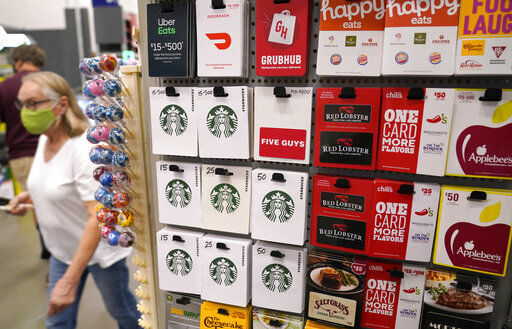NEW YORK — Like many shoppers, Kathleen Webber understands the struggles of getting the right gifts for her three children this holiday shopping season amid widespread shortages.
She promised to buy her 23-year-old son the Sony Corp. PlayStation 5, but he hasn’t been able to get his hands on the popular game console. So now Webber says she may have to get him the next best thing — a used smart phone.
“I just don’t know where to get one,” the Yardley, Pa., resident said of the PS5. “It’s like the Tickle Me Elmos” from 1996.
The holidays have always been defined by disappointing out-of-stock messages on the most popular items. But the pandemic-induced supply chain snarls have created unprecedented shortages across all types of products, from the chips that go into gaming consoles to more mundane items like ties and pajamas.
That has many customers buying early as shortfalls are only expected to worsen as the holiday season moves into the final stretch.
Some shoppers like Danny Groner aren’t being choosy.
When Groner realized he needed a new tie for a wedding in early December, he found the perfect answer on Amazon: a $7.99 skinny black and white tie that he was told would arrive in time.
But four days later, he received an email message informing him the tie was out of stock and it wouldn’t arrive until January. That sent the New York publicist into a fit of desperation and forced him to go back on the site for any tie that would meet the fast approaching deadline.
“It didn’t matter to me whether it was ugly — it got here,” says Groner, who settled on a yellow and blue checkered tie.
On Cyber Monday — the biggest online shopping day of the year — the prevalence of out-of-stock messages rose 8% compared to a week earlier, according to Adobe Digital Economy Index. From November 1 through November 29, the number of out-of-stock messages soared close to twofold compared with pre-pandemic levels in January 2020 and up 258% from November 2019, Adobe said.
In response, stores like Kohl’s have added new online tools to help push shoppers to substitutes if their top choice is gone. Shipt, a grocery delivery service owned by Target, now offers customers substitute suggestions based, in part, on their prior shopping behavior. And technology company Obsess, which creates virtual shopping experiences for such brands as American Girl and Ralph Lauren, added tools that recommend next best items if the shopper clicks on something that’s out of stock; it also offers quizzes to help figure out what they would like.
But there are plenty of shoppers who won’t be happy with alternatives, particularly when it comes to must-have toys like Spinmaster’s Gabby’s Dollhouse Purrfect Playset and Moose Toys’ Magic Mixies Magical Misting Cauldron. Some are resorting to eBay where they’re paying three times more than the suggested retail price. Experts also believe they will turn to more to gift cards if they don’t like what they see.
A lot is at stake for retailers. If shoppers can’t get what they want at one store, they could go to another competitor or just not buy an alternative. That could dampen holiday sales, which are expected to be up anywhere between 8.5% to 10.5% for the November-December period, compared with the year-ago period, according to the National Retail Federation, the nation’s largest retail trade group.
Experts say that the pandemic trained shoppers to try new brands and items when their first choice couldn’t be found. For example, when consumer product makers and essential retailers saw a huge run on toilet paper in the spring of 2020, it forced shoppers to abandon the brands they’d been loyal to and seek out alternatives.
Things got more complicated as Americans enthusiastically emerged from months of pandemic lockdowns, eager to shop again. Retailers and manufacturers of all types were caught flat-footed as they also contended with a shortage of containers that carry the goods, bottlenecks at ports and a shortage of workers needed to unload the goods. And global chip shortages have increased the list of hard-to-find gadgets. Many industry analysts believe the supply chain issues will not be resolved until next year.
Victoria’s Secret told analysts last week that nearly 50% of its holiday merchandise is in transit. It said it ordered 200 million units of merchandise for the fourth quarter holiday period, but 90 million of those items are delayed because of supply chain clogs.
“Today, we have 30% less PJs in our system than we had a year ago,” Victoria’s Secret CEO Martin Waters told analysts. “That is clearly bad for business.”
Smaller retailers are having an even harder time stocking shelves. A survey conducted by the National Federation of Independent Businesses, a lobbying group for small businesses, said that 39% reported that supply chain disruptions have had a significant impact on their business. Another 29% report a moderate impact and 21% report a mild impact. Only 10% of owners reported no effect.
Jim Silver, editor-in-chief of TTPM, a toy review site, says he always used to tell shoppers on the hunt for a scarce toy to show up at stores on Friday night when shipments arrive for the weekend. But he says that doesn’t apply this season since the shipments are so unpredictable.
For the holidays, he advises shoppers to go online to get a view of which stores have the item they’re looking for. He also suggests looking for toys like board games that are made in the U.S
“Things that are made here are going to have better stock inventories,” Silver said.


